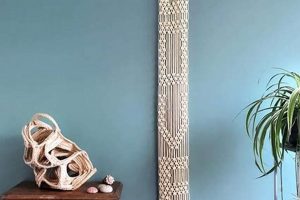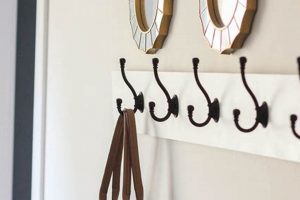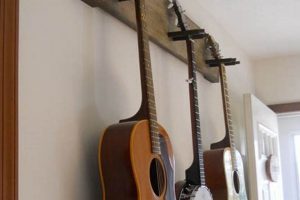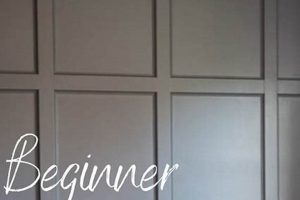The practice of creating a reflective surface arrangement on a wall, utilizing readily available and inexpensive mirrored tiles from a large retail chain, defines a specific approach to home dcor. This method offers a budget-conscious option for visually expanding a room or adding a decorative element. For example, individuals may purchase several packs of square mirror tiles from a specific retailer and adhere them to a wall in a grid pattern to achieve the desired aesthetic effect.
Implementing this mirrored surface treatment can contribute significantly to perceived room size, particularly in smaller spaces. The reflective properties of the mirrors create an illusion of depth, making the area feel more open and airy. Furthermore, this type of installation can serve as a focal point within a room, adding visual interest and potentially increasing the ambient light through reflection of existing light sources. The accessibility and affordability of the materials have contributed to its popularity as a cost-effective decorating solution.
The following will examine specific considerations for installing such a reflective wall covering, including surface preparation, adhesive selection, and layout strategies. Furthermore, potential challenges and safety precautions associated with this home improvement project will be addressed, offering a comprehensive guide to successful implementation.
Installation Guidance for Budget-Conscious Reflective Wall Treatments
The following guidelines offer critical considerations for installing reflective wall features using accessible and economical materials.
Tip 1: Surface Preparation is Paramount: Ensure the wall surface is clean, dry, and free of debris. Imperfections can compromise adhesion and result in uneven mirror placement. A thorough cleaning and light sanding are recommended before application.
Tip 2: Select Appropriate Adhesive: Choose an adhesive specifically formulated for mirror installation. Construction adhesives not designed for mirrors may damage the reflective backing. Verify compatibility and follow the manufacturer’s instructions meticulously.
Tip 3: Plan the Layout Strategically: Prior to adhering any mirrors, create a detailed layout. Consider centering the arrangement on the wall and ensuring equal spacing between tiles. Use a level to maintain straight lines throughout the installation.
Tip 4: Utilize Spacers for Uniformity: Employ spacers between the mirror tiles to achieve consistent and professional-looking gaps. This ensures visual uniformity and aids in maintaining proper alignment during installation.
Tip 5: Cut Tiles with Precision: When trimming tiles to fit edges or corners, use a specialized glass cutter and exercise caution. Uneven cuts will detract from the overall aesthetic. Safety glasses are essential during this process.
Tip 6: Address Edges with Trim: Consider using trim pieces around the perimeter of the mirrored area to conceal raw edges and create a finished appearance. This adds a refined touch and protects the edges of the tiles.
Tip 7: Allow Adequate Curing Time: Following adhesive application, allow sufficient curing time as specified by the adhesive manufacturer. Prematurely disturbing the mirrors can compromise the bond and necessitate repairs.
Consistent application of these strategies maximizes the likelihood of a successful and visually appealing reflective wall treatment, achieved economically.
Attention to these details will contribute to a lasting and impactful enhancement of the space.
1. Affordability
The economic accessibility of materials is a primary driver behind the popularity of creating mirrored wall features using products from mass-market retailers. The relatively low cost, when compared to custom-designed mirrored surfaces or professional installation services, makes this option attractive to budget-conscious homeowners and renters.
- Reduced Material Costs
Purchasing mirror tiles from large discount retailers typically results in significantly lower material expenses compared to specialty glass shops or home improvement stores. Bulk purchasing options further contribute to cost savings, particularly for larger wall areas.
- Elimination of Professional Labor Fees
A do-it-yourself approach removes the need to hire professional installers, thereby eliminating potentially substantial labor costs. This self-execution aspect allows individuals to allocate resources towards materials and tools instead of professional service fees.
- Simplified Installation Techniques
The simplicity of adhering pre-cut mirror tiles to a wall, as opposed to cutting and installing large mirror sheets, minimizes the need for specialized tools and expertise. This simplification translates into reduced equipment costs and a lower barrier to entry for individuals with limited home improvement experience.
- Potential for Repurposing and Upcycling
Individuals may choose to repurpose existing mirrors or acquire discounted or slightly damaged tiles, further reducing material costs. This approach aligns with sustainable practices and offers a creative outlet for resourcefulness.
The confluence of these factors underscores the pivotal role affordability plays in the prevalence of this specific reflective wall dcor technique. The combination of accessible materials, simplified installation, and the potential for repurposing positions this technique as an economically viable solution for enhancing interior spaces.
2. Surface Preparation
Proper surface preparation is a critical determinant of the success and longevity of any reflective wall installation involving economical materials sourced from mass-market retailers. The integrity of the adhesive bond between the mirror tiles and the wall surface directly impacts the overall appearance and structural stability of the finished product.
- Cleaning and Degreasing
The removal of dust, dirt, grease, and other contaminants from the wall surface is essential for ensuring proper adhesive contact. Residual substances can impede the bonding process, leading to eventual mirror detachment. For example, walls in kitchens or bathrooms often require thorough degreasing to eliminate cooking oils or soap scum.
- Repairing Imperfections
Addressing surface irregularities, such as cracks, holes, or uneven textures, is crucial for creating a smooth and uniform substrate. These imperfections can cause mirror tiles to sit unevenly, creating visual distortions and potentially weakening the adhesive bond. Filling and sanding these areas prior to installation is recommended.
- Priming for Adhesion
Applying a primer to the wall surface can significantly enhance adhesive bonding, particularly on porous or glossy surfaces. The primer creates a more receptive substrate, promoting a stronger and more durable connection between the mirror tiles and the wall. The selection of an appropriate primer should be based on the wall material and the type of adhesive being used.
- Ensuring Dryness
Moisture can severely compromise the adhesive bond, leading to premature failure and potential damage to the wall surface. It is imperative to ensure that the wall is completely dry before commencing the installation process. This may involve addressing any leaks or dampness issues and allowing sufficient drying time after cleaning or priming.
Therefore, meticulous surface preparation, encompassing cleaning, repair, priming, and ensuring dryness, constitutes a foundational element for achieving a professional-looking and long-lasting mirrored wall feature using affordable materials. Neglecting these steps can compromise the integrity of the entire installation, resulting in aesthetic flaws and potential safety hazards.
3. Adhesive Selection
Adhesive selection represents a critical juncture in the successful execution and long-term stability of a do-it-yourself mirrored wall project utilizing materials from retailers such as Walmart. The improper choice of adhesive can lead directly to mirror detachment, damage to the mirrored surface or the underlying wall, and potential safety hazards. The relatively low cost of the mirror tiles themselves amplifies the importance of a suitable adhesive to prevent project failure and associated rework. For example, using a generic construction adhesive not specifically designed for mirrors may contain solvents that degrade the silver backing, leading to discoloration and eventual detachment. Such a failure would necessitate the removal of the damaged tiles and the re-installation with the correct adhesive, effectively negating the initial cost savings.
The ideal adhesive for this type of project must possess several key characteristics. It should be specifically formulated for use with mirrors to avoid damaging the reflective backing. It must provide a strong, permanent bond to both the mirror and the wall surface, accounting for variations in material composition. Moreover, it should exhibit resistance to moisture and temperature fluctuations, particularly in bathrooms or kitchens. Many commercially available mirror adhesives meet these criteria, often labelled as “mirror mastic” or “mirror adhesive,” and are readily available at home improvement stores. Before application, reading the adhesive’s specifications and instructions is crucial to guarantee compatibility with the specific mirror tiles being used and the intended wall surface. Further, conducting a small test application on an inconspicuous area of the wall is highly recommended to verify adhesion and prevent potential damage or discoloration.
In summary, the seemingly simple act of adhering inexpensive mirror tiles from a mass-market retailer requires a deliberate and informed approach to adhesive selection. The consequences of an unsuitable choice can be significant, ranging from aesthetic imperfections to complete project failure and potential safety risks. Therefore, prioritising the selection of a mirror-specific adhesive, coupled with thorough testing and adherence to manufacturer’s guidelines, is paramount to achieving a durable, visually appealing, and safe reflective wall installation.
4. Layout Planning
Effective layout planning serves as a foundational element in the successful execution of a do-it-yourself mirrored wall project using readily available, cost-effective materials. A well-conceived layout minimizes material waste, ensures aesthetic coherence, and contributes significantly to the overall visual impact of the finished installation.
- Spatial Measurement and Calculation
Accurate measurement of the intended wall surface is paramount. This involves determining the precise dimensions and calculating the number of mirror tiles required to cover the designated area. Failure to accurately measure the space can result in insufficient materials or, conversely, excess tiles, leading to unnecessary expenditures. For instance, if a wall measures 8 feet wide by 4 feet high, and the chosen mirror tiles are 12 inches square, a precise calculation will determine the optimal number of tiles needed to avoid significant gaps or excessive cutting. Inaccurate measurements may lead to an asymmetrical appearance or costly material waste.
- Centering and Symmetry Considerations
Determining the placement of the central tile or point of symmetry dictates the overall visual balance of the installation. Centering the arrangement ensures a balanced appearance, while asymmetrical designs can create a more dynamic and visually engaging effect. This decision must be made during the planning phase to ensure that the tile layout aligns with the desired aesthetic outcome. A centered layout, for example, might involve starting with a tile precisely in the middle of the wall and working outwards, while an asymmetrical design could deliberately offset the arrangement to create a unique focal point.
- Accounting for Obstacles and Architectural Features
Any existing obstacles, such as electrical outlets, light switches, or architectural moldings, must be factored into the layout planning process. Failing to account for these features can necessitate awkward cuts or the displacement of tiles, compromising the overall aesthetic appeal. A well-planned layout will strategically incorporate these features, either by precisely cutting tiles to fit around them or by designing the arrangement to intentionally integrate them into the overall composition. Careful consideration prevents unsightly gaps or misalignments and ensures a seamless integration with the existing environment.
- Tile Spacing and Alignment
Consistent tile spacing contributes significantly to the professional appearance of the finished installation. Maintaining uniform gaps between tiles, often achieved through the use of spacers, ensures visual coherence and prevents the arrangement from appearing haphazard or uneven. Similarly, ensuring proper alignment of the tiles, both horizontally and vertically, is crucial for achieving a polished and refined look. Precise alignment can be facilitated by using a level or laser level to establish reference lines and maintain consistency throughout the installation process. Inconsistent spacing or misalignment can detract from the overall aesthetic and undermine the intended visual impact.
The aforementioned facets of layout planning, encompassing spatial measurement, centering considerations, accommodation of obstacles, and uniform tile spacing, collectively underscore the importance of meticulous preparation in the successful implementation of this specific reflective wall dcor technique. By dedicating sufficient time and attention to the layout planning phase, individuals can mitigate potential challenges, optimize material utilization, and ultimately achieve a visually appealing and professionally executed do-it-yourself mirrored wall feature.
5. Cutting Precision
Cutting precision represents a pivotal factor influencing the aesthetic outcome and structural integrity of a reflective wall installation using economical mirror tiles. In the context of “diy walmart mirror wall,” achieving accurate cuts directly impacts the seamless integration of tiles, the overall visual appeal, and the prevention of potential safety hazards associated with improperly sized or shaped pieces.
- Mitigation of Gaps and Misalignments
Precise cutting techniques minimize the occurrence of unsightly gaps or misalignments along the edges of the mirrored surface. When mirror tiles are not accurately cut to fit the available space, uneven gaps can appear, detracting from the visual coherence of the installation. This is particularly relevant around corners, obstacles (such as electrical outlets), and along the perimeter of the wall. Accurate cuts ensure that the tiles fit snugly against each other and the surrounding structures, creating a more polished and professional appearance. The absence of cutting precision results in visible imperfections, diminishing the impact of the reflective surface.
- Optimization of Material Utilization
Cutting mirror tiles with precision optimizes material utilization and minimizes waste. Inefficient cutting techniques can lead to significant material loss, increasing the overall cost of the project and potentially requiring additional purchases. Precise measurements and careful cutting strategies allow for the most efficient use of each tile, reducing the amount of discarded material. This is particularly important when working with larger or irregularly shaped spaces, where optimizing material utilization can lead to substantial cost savings and a more sustainable approach to the installation process.
- Enhancement of Aesthetic Coherence
Cutting precision enhances the overall aesthetic coherence of the mirrored wall. When tiles are accurately cut and aligned, the reflective surface appears more uniform and seamless. This creates a more visually appealing and sophisticated effect. In contrast, uneven cuts or misaligned tiles can disrupt the flow of light and create visual distortions, detracting from the intended aesthetic impact. Precisely cut tiles contribute to a cohesive and visually harmonious reflective surface, enhancing the overall aesthetic quality of the “diy walmart mirror wall” installation.
- Reduction of Safety Hazards
Accurate cutting reduces the risk of safety hazards associated with sharp edges or poorly fitted tiles. Improperly cut mirror tiles can create exposed edges that are sharp and potentially dangerous, particularly in areas where they may be easily accessible. Precise cutting techniques ensure that all edges are properly trimmed and smoothed, minimizing the risk of cuts or injuries. Additionally, accurately sized and shaped tiles are less likely to become dislodged or detached from the wall, reducing the risk of falling debris. Prioritizing cutting precision enhances the safety of the installation and mitigates potential risks to individuals in the vicinity.
In conclusion, the correlation between cutting precision and “diy walmart mirror wall” is undeniable, underscoring its role in achieving a visually appealing, cost-effective, and safe installation. Precision cutting techniques not only enhance the aesthetic coherence and optimize material utilization but also minimize potential safety hazards, contributing to a successful and long-lasting reflective wall feature.
6. Edge Treatment
Edge treatment, often overlooked in budget-conscious home improvement projects, plays a crucial role in the aesthetic refinement and structural integrity of a reflective wall created using affordable mirror tiles. The method by which the exposed borders of the installed mirror surface are finished directly influences the visual appeal, perceived quality, and safety of the “diy walmart mirror wall” installation.
- Concealment of Raw Edges
The primary function of edge treatment is to conceal the unfinished, and potentially sharp, edges of the mirror tiles. Raw edges, particularly those resulting from cutting or trimming, can detract from the overall polished appearance of the mirrored surface. Edge treatment options, such as trim molding or edge banding, provide a clean and visually appealing border, masking imperfections and creating a more refined look. For instance, applying a thin strip of wood molding painted to complement the room’s decor can effectively hide the raw edges and create a finished frame around the mirror installation.
- Protection Against Damage
Edge treatment provides a degree of protection to the vulnerable edges of the mirror tiles, reducing the likelihood of chipping, cracking, or delamination. The edges of mirrors are particularly susceptible to damage from impacts or abrasion. The application of edge banding or trim molding creates a buffer zone, shielding the edges from potential hazards and prolonging the lifespan of the installation. For example, installing a flexible vinyl edge trim can absorb minor impacts, preventing the edges of the mirror tiles from fracturing or chipping.
- Enhancement of Visual Cohesion
Edge treatment contributes to the overall visual cohesion of the “diy walmart mirror wall” by creating a defined border and integrating the installation with the surrounding decor. The choice of edge treatment materials and colors can either complement or contrast with the existing aesthetic, enhancing the visual impact of the mirrored surface. A carefully selected trim molding can tie the mirror installation to the room’s architectural details, creating a more harmonious and integrated design. For example, using a metallic edge trim can add a touch of sophistication and elegance to a simple mirrored wall, while a painted trim can blend seamlessly with the existing wall color.
- Safety Improvement
The application of edge treatment improves the safety of the mirror installation by covering sharp edges and preventing accidental cuts or scrapes. Unfinished mirror edges can pose a safety hazard, particularly in high-traffic areas or homes with children. Edge treatment options, such as rounded edge trim or safety edging, create a smooth and safe surface, reducing the risk of injury. For example, using a self-adhesive safety edging can effectively cover sharp edges, providing a soft and cushioned surface that minimizes the potential for cuts or abrasions.
In conclusion, edge treatment is an essential component of a successful “diy walmart mirror wall” project, contributing significantly to the aesthetic appeal, structural integrity, and safety of the installation. Selecting an appropriate edge treatment option based on the desired aesthetic, budget constraints, and safety considerations is crucial for achieving a professional-looking and long-lasting reflective wall feature.
7. Proper Curing
Proper curing of adhesives is a non-negotiable element in the successful and enduring execution of a do-it-yourself mirrored wall project, particularly when utilizing affordable materials sourced from mass-market retailers. Adequate curing time allows the adhesive to achieve its maximum bonding strength, ensuring the long-term stability and visual integrity of the installed mirrors.
- Development of Maximum Bond Strength
Adhesives require a specific period, often referred to as the curing time, to fully develop their bonding strength. During this period, the chemical components within the adhesive undergo a process of cross-linking or polymerization, resulting in a hardened and durable bond. Premature stress or disturbance of the adhered surfaces before complete curing can significantly weaken the bond, leading to potential detachment or slippage. For example, if mirror tiles are installed and then immediately subjected to weight or pressure before the adhesive has fully cured, the bond may be compromised, resulting in the tiles becoming loose over time.
- Prevention of Mirror Displacement
Insufficient curing time can result in the gradual displacement of mirror tiles from their intended positions on the wall. As the adhesive cures, it shrinks slightly, exerting a force on the adhered surfaces. If the bond is not sufficiently strong due to inadequate curing, this shrinkage can cause the tiles to shift or slide, disrupting the alignment and creating a visually unappealing outcome. Precise placement and leveling during installation are rendered ineffective if the adhesive bond is not allowed to fully develop, leading to a compromised final result.
- Minimization of Moisture-Related Issues
Proper curing contributes to the resistance of the adhesive bond to moisture and humidity, particularly in environments prone to such conditions, such as bathrooms or kitchens. A fully cured adhesive forms a more impermeable barrier, preventing moisture from penetrating the bond and potentially causing degradation or weakening. Premature exposure to moisture can disrupt the curing process and compromise the long-term durability of the adhesive, leading to potential issues such as mold growth or adhesive failure.
- Long-Term Structural Integrity
Adhering to the recommended curing time ensures the long-term structural integrity of the “diy walmart mirror wall” installation. A properly cured adhesive provides a durable and resilient bond that can withstand the stresses and strains of everyday use, such as temperature fluctuations, vibrations, and minor impacts. This long-term stability is essential for maintaining the aesthetic appeal and preventing costly repairs or replacements over time. Conversely, neglecting the curing time can lead to premature failure of the adhesive bond, resulting in a shortened lifespan for the installation and potential safety hazards.
Therefore, observing the manufacturer’s recommended curing time is an indispensable step in the process of installing an affordable mirrored wall feature. The longevity, visual appeal, and structural stability of the project are contingent upon the complete and proper curing of the chosen adhesive, underscoring the importance of patience and adherence to manufacturer’s instructions.
Frequently Asked Questions Regarding Economical Reflective Wall Installations
The following questions address common concerns and misconceptions associated with creating mirrored wall features utilizing accessible and budget-friendly materials.
Question 1: What is the typical lifespan of a reflective wall installation using affordable materials?
The lifespan is contingent upon several factors, including the quality of the adhesive, thoroughness of surface preparation, and environmental conditions. Properly installed features can last for several years, while poorly executed projects may experience issues within a shorter timeframe.
Question 2: Can these mirrored tiles be installed on textured walls?
While possible, installation on textured walls is not recommended without proper surface preparation. Texture can impede adhesive contact, leading to potential detachment. Smoothing the wall surface prior to installation is advisable for optimal results.
Question 3: What is the best method for cleaning these mirror tiles?
A soft cloth and a mild glass cleaner are recommended. Abrasive cleaners or scouring pads can scratch the reflective surface and should be avoided.
Question 4: Are these installations suitable for high-humidity environments such as bathrooms?
Yes, but the adhesive must be specifically formulated for use in high-humidity environments. Additionally, proper ventilation in the bathroom is crucial to prevent moisture build-up that could compromise the adhesive bond.
Question 5: What is the recommended procedure for removing these mirror tiles without damaging the wall?
Carefully scoring the adhesive with a utility knife and gently prying the tiles away from the wall is recommended. The use of a heat gun can soften the adhesive, facilitating easier removal. However, some wall damage is possible, and patching may be required.
Question 6: Is it possible to install these mirrors on a ceiling?
Installation on a ceiling is not recommended due to safety concerns. The risk of mirror detachment and potential injury is significantly higher with ceiling installations. Alternative decorative treatments are advisable for ceilings.
Careful consideration of these points will contribute to a more informed decision-making process regarding the implementation of this type of reflective wall treatment.
The subsequent will explore various aesthetic considerations for customizing such an installation.
Concluding Remarks on Economical Reflective Wall Treatments
This exploration has provided a detailed examination of the process involved in creating a reflective wall surface using affordable mirror tiles. Key considerations, including meticulous surface preparation, appropriate adhesive selection, strategic layout planning, cutting precision, refined edge treatment, and ensuring proper curing, have been thoroughly addressed. The overarching aim has been to illuminate the practical steps and potential challenges associated with implementing this cost-effective home decor solution.
While the accessibility and affordability of “diy walmart mirror wall” projects present an enticing option for enhancing interior spaces, a comprehensive understanding of the outlined principles is paramount. Diligent adherence to these guidelines will significantly increase the likelihood of achieving a visually appealing, structurally sound, and ultimately, safe and enduring reflective wall feature. Individuals should proceed with careful planning and execution to maximize the benefits and minimize potential drawbacks of this budget-conscious home improvement endeavor.







